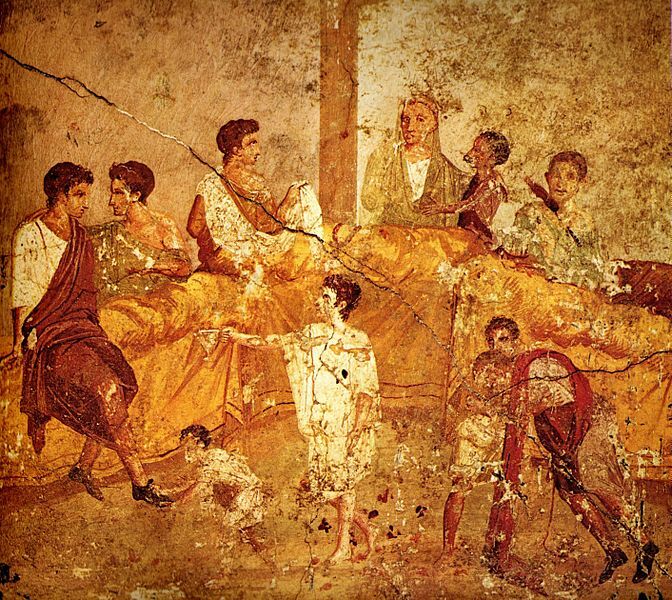Roman society was clearly hierarchical, with legally defined privileges allotted to different classes and countless informal differences in attitudes toward the classes in everyday life.
Painting from Pompeii, now in the Museo Archeologico Nazionale (Naples), showing a banquet or family ceremony feature multiple aspects of Roman society.
In ancient society, the population was divided into two groups: patricians and plebeians.
Patricians | Plebians |
The patrician class were the descendants of the most ancient and powerful noble families. They were landowners, lived in large houses and they had political power in the Senate. The patricians married and did business only with people of their own class. | Plebeians were mainly artisans or peasants who worked the patricians’ land; they lived in apartments and they had no political rights. If they were lucky plebeians could become clients (obedient servants) of a patrician family. They offered their services in return received the protection of the head of the patrician family, who became their patron. |
Roman Society in the Era of the Empire 27BC – 1453AD
Below is the pyramid of Roman society, with the emperor at top and slaves at the bottom. Multiple layers existed between them. While it was possible to move up and down this social latter, as the categories were not immutable, changing one’s social standing was extremely difficult and only possible through meritocratic institutions such as the military. So, social mobility was very difficult in Roman society.
“When Did The Roman Empire Really End?”
For the full “History Unplugged” podcast, click here!
The Emperor
The Emperor was the head of Roman society and ruler of all Rome
Patrician Families
Wealthy influential landowning families
Senators
In roman society, they served in the Senate and governed Rome
Equestrians
Wealthy property owners who chose business over politics in Roman society
Plebeians
Working class. Men without substantial wealth who worked for their living at jobs such as artisans, craftsmen, bakers etc
Freed Slaves
Slaves who had either been given their freedom or had paid for their freedom and now worked for their living.
Slaves
Generally prisoners of war but sometimes abandoned children who were owned by their master.
This article is part of our larger selection of posts about Ancient Rome. To learn more, click here for our comprehensive guide to Ancient Rome.
Additional Resources About The Romans
Cite This Article
"Roman Society and Social Classes: How Were They Structured?" History on the Net© 2000-2024, Salem Media.
April 21, 2024 <https://www.historyonthenet.com/roman-society-and-social-classes>
More Citation Information.

